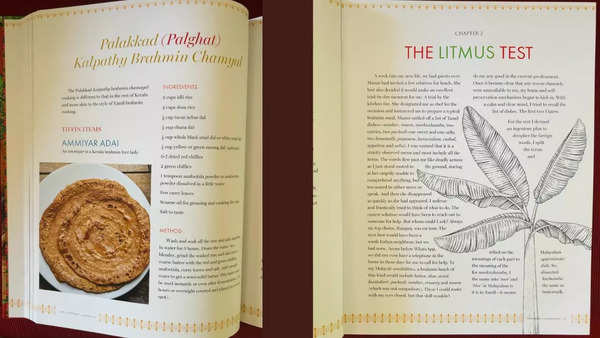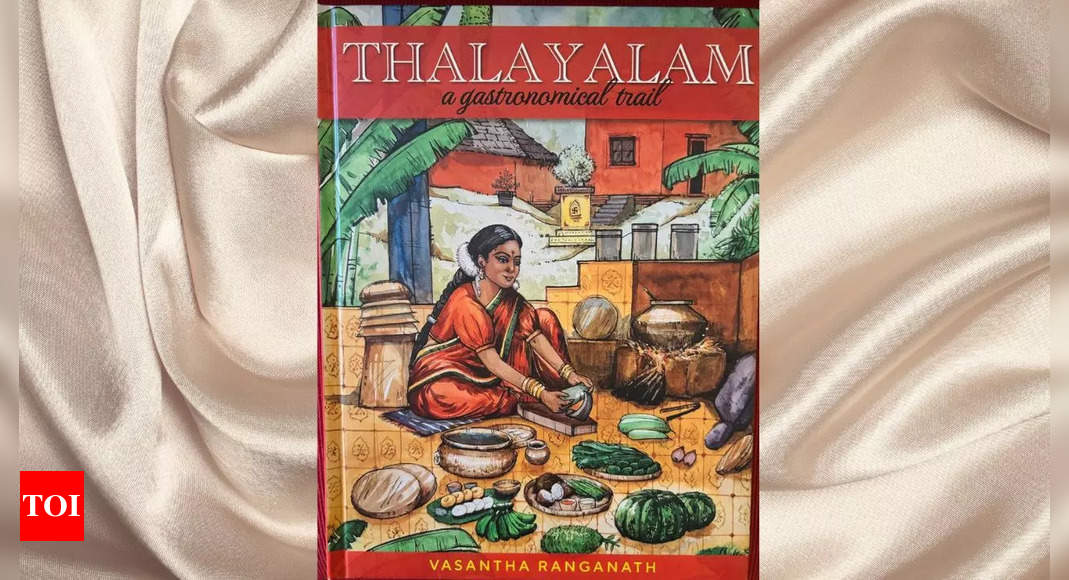Crafted entirely by hand during the challenging times of the COVID-19 pandemic, ‘Thalayalam- A Gastronomical Trail’ is a culinary masterpiece comprising over 400 recipes and narratives drawn from the 75-year journey of Vasantha Ranganath. Over the years, she has experimented with thousands of dishes within the confines of her kitchen, and this book stands as a testament to her rich and varied gastronomic experiences.In an exclusive interview with us she spoke about the book, its recipes and the sweet-little tales associated with the book.
1. What does the word Thalayalam mean?
Thalayalam is a language born out of the sheer helplessness I felt in my husband’s home when my bookish knowledge of Tamil failed me. I would add Malayalam words whenever I got stuck for words while talking. We were after all from two states, I – a Malayali and he a Tamilian, hence the problem and my own solution for it “Thalayalam”, a word that doesn’t exist in any dictionary otherwise.
2. Those who have gone through your book would know that you are quite a storyteller. What made you write down a recipe book?
Penned during the pandemic, entirely by hand, “Thalayalam – A Gastronomic Trail”, is a food memoir more than a cookbook. It is interwoven with my life’s experiences as a young bride, childhood memories, places I visited, all these have connection with the food I learned to cook and enjoy.
My family loves the food I cook. My daughter and son-in-law pushed me to pen down the heirloom recipes and the ones I invented to suit my family’s palette as they thought this would be the best way to preserve these for the generations to come.
This inspired me to start writing and I found that writing just the recipes without the stories behind them didn’t feel right. After all, there was so much I wanted to share with my grandchildren and their children ahead.
During the pandemic anyway I was so bored and also so anxious seeing all the challenges around, writing the book was therapeutic, it took me just three months to write in a flow and I was quite overwhelmed when I put my pen down seeing that I had managed to write down 600 recipes. Editing and designing the book took longer as it was all during the pandemic.
3. For most of the people in the rest of India and abroad, South Indian food is categorised as one cuisine. What are the different nuances of different states?
The South of India is a rich and complex region with varied palettes. Take for example even the quintessential “Sadya”, the several courses of a traditional Kerala meal which can go upto even 50 dishes served on a banana leaf. This too varies from district to district and community to community in Kerala itself. As for the different states, the cooking oil is so different. Its sesame oil in Tamil Nadu, Groundnut oil in Andhra Pradesh and Karnataka itself is a mix of coconut and others.
------Advertisement-----

Portions from ‘Thalayalam- A Gastronomical Trail’
------Advertisement-----
The use of coconut is more in Kerala and less in Karnataka and Andhra and in Tamil Nadu it’s the least. Certain vegetables are typical to Kerala like the Tapioca, Chinese potato, Breadfruit and Jackfruit. Rice too is different everywhere. In fact, banana is produced more in Tamil Nadu but the varieties are more in Kerala. However the only one commonality is the use of the Banana leaf to eat upon and even cook with.
4. However regressive it may sound, do you think cooking did have a role to play in keeping marriages intact as it kept the family glued together gastronomically?
Yes it did and still does. In fact not just marriage, even families. A meal eaten together is anyway a great bonding experience where one shares and tells stories about the day or week gone by. Moreso, a meal that offers you your favourite dishes is therapeautic. For me it’s a thrill to see everyone gushing over a family favroutite and to see the children even fight each other for the next poori coming out of the kitchen….
Cooking heirloom recipes is also very important to maintain the unique identity of a family, one that we take with them from our homes to what we learn in our marital homes, it’s a coming together of family histories and a matter of great pride for the whole family.
5. Through the book you have also set some fine examples in managing acquired relationships. Give us some tips on managing your in-laws that worked wonders for you
Keep a positive outlook always and patiently wait for things to sort out. They always do and on their own. Confrontations and engaging is only energy spent in futility. Its best to keep calm and wait. This will strengthen your relationship with your spouse as that is the pillar on which everything stands. So if some times we have to let things go by, its alright as nothing and nobody is more significant in a marriage than the married couple. The family and everything else comes after.
And of course, cooking for your in-laws and win hearts!
6. What is the secret of a long and happy marriage? And why do you think they do not survive these days?
Patience and conversation – these are keys to a good marriage. Marriages don’t survive these days also because of external pressures. Too much stress and too many expectations of all kinds, from physical appearance to social appearance, its all too much and burns people out. There are also a lot of unaddressed mental health issues as well. And where is the time to talk to each other amidst work pressure and financial worries? Little things get pent up as nobody is talking or listening and then it all blows up one day.
And then there is no cooking, its more ordering in… In Tamil we say “kai– mannam” a phrase that celebrates and cherishes the hand that cooks, if this is there then the meal is one of love and is capable of healing even broken hearts. However where is the “kai – mannam” in a Zomato meal? So even that avenue for repairing a fractured relationship is not there.
7. What is your favourite recipe from the book? And why?
The first chapter – “Beginning of a new chapter, the married life” is my favourite actually. My husband was a tea drinker when we started life together where as I needed my filter coffee in the morning. I would drink my hot cappa sitting next to him. The aroma of the coffee enticed my stubborn hubby and reluctantly he started taking sip after sip from my cup, finally after a month I won him over! He became a coffee drinker and thereafter he could never savour the coffee anyone else prepared till his last day. I served him coffee in the mornings, it was a beloved ritual of ours sipping the hot strong aromatic coffee I prepared and reading the newspapers together. Of course, I oversaw it all, right from getting the right permutation of the beans powdered to making the perfect decoction and then of course preparing it with milk, just the way he loved it.
8. Some cooking tips that have worked wonders for you… always
Planning and preparing for the meal is more important than actually cooking. It all starts from observing and noting the taste buds of who you are cooking for. In fact I even cooked looking at the moods of my family members and what they emotionally required, then planned the meals at home. I still do this. Once the meal is prepared. Its really important to taste and see if it has come upto your expectations. Knowing the little tips for adjusting salt, sweetness, chilly and the different spices is really key in fact.
While plating today has become a big deal, even our traditional meals have some plating norms. This is also something that makes a meal even more alluring.
Robin Sharma on ‘The Wealth Money Can’t Buy’, spirituality, writing, and more
